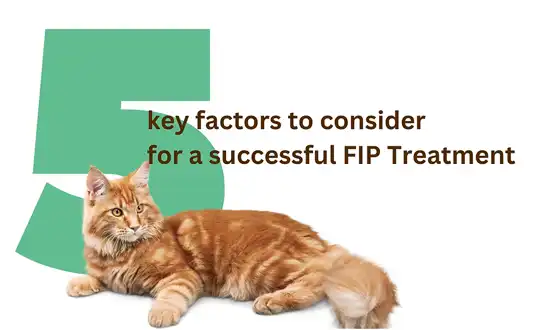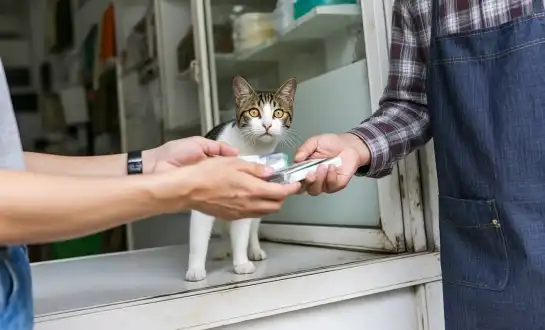The Effects of FIP on Cat Breeding Practices
How FIP outbreaks impact cattery management?
Worldwide, cat breeding techniques have been greatly affected by the fatal illness known as Feline Infectious Peritonitis (FIP). In this post, we'll look at the effects of FIP outbreaks on cattery management, preventative methods, and breeding programs in the long run. GS 441524's function in GS-441524 FIP treatment and its significance for breeders will also be covered.
|
|
|
How FIP outbreaks impact cattery management?
FIP outbreaks can have severe consequences for cat breeders, requiring immediate and comprehensive action to protect their cats and maintain the integrity of their breeding programs.
Quarantine and isolation procedures
When FIP is suspected or confirmed in a cattery, implementing strict quarantine measures becomes crucial. Affected cats must be isolated from healthy ones to prevent the spread of the virus. This often involves creating separate living areas, using dedicated equipment, and implementing rigorous sanitation protocols.
Testing and monitoring
Regular testing of all cats in the cattery becomes essential during an FIP outbreak. This includes both symptomatic and asymptomatic cats, as the virus can spread silently before clinical signs appear. Monitoring involves frequent health checks, blood tests, and potentially advanced diagnostics like PCR testing.
Breeding program adjustments
FIP outbreaks often necessitate temporary or permanent changes to breeding schedules. Breeders may need to postpone planned matings, adjust kitten socialization practices, or even retire certain breeding lines if they show a higher susceptibility to FIP. Incorporating proper FIP treatment protocols during these adjustments can help manage risks and support the overall health of affected or vulnerable cats.
Preventing FIP transmission in breeding facilities
Prevention is key in managing FIP risk in cat breeding facilities. Implementing comprehensive strategies can significantly reduce the likelihood of outbreaks and protect valuable breeding stock.
Biosecurity measures
Robust biosecurity protocols are essential for preventing FIP transmission. These include:
- Limiting access to the cattery to essential personnel only
- Implementing foot baths and hand sanitization stations
- Using separate clothing and equipment for different areas of the facility
- Regular disinfection of all surfaces and shared spaces
Stress reduction strategies
Stress is a significant factor in FIP development. Breeders can reduce stress by:
- Providing enriched environments with ample space and stimulation
- Maintaining consistent routines
- Minimizing changes in social groups
- Ensuring optimal nutrition and healthcare
Genetic considerations
While the genetic basis of FIP susceptibility is not fully understood, some breeding lines may be more prone to the disease. Breeders should carefully monitor the health history of their breeding stock and consider genetic diversity in their breeding programs to potentially reduce FIP risk. Integrating preventive measures and proper FIP treatment strategies can further support overall feline health and minimize the likelihood of disease development.
 |
 |
Long-term consequences of FIP on breeding programs
The impact of FIP on cat breeding programs can be far-reaching and long-lasting, affecting various aspects of cattery operations and the broader breeding community.
Genetic pool alterations
FIP outbreaks may lead to the loss of valuable breeding stock, potentially reducing genetic diversity within certain breeds. This can result in:
- Narrowing of breed-specific traits
- Increased inbreeding coefficients
- Potential emergence of other health issues due to reduced genetic variability
Economic impact
The financial consequences of FIP outbreaks can be substantial for breeders, including:
- Veterinary costs for testing and treatment
- Loss of income from reduced kitten sales
- Expenses related to implementing enhanced biosecurity measures
- Potential closure of breeding programs in severe cases
Reputation management
FIP outbreaks can significantly impact a breeder's reputation within the cat fancy community. Transparent communication about FIP cases and prevention measures is crucial for maintaining trust with potential kitten buyers and other breeders.
Advancements in FIP treatment
Recent developments in FIP treatment, particularly the use of GS 441524, have offered new hope for affected cats. This antiviral compound has shown promising results in treating FIP, potentially allowing breeders to save valuable breeding stock that would have been lost in the past. However, the use of GS 441524 in breeding cats raises ethical and practical considerations that breeders must carefully navigate.
Conclusion
FIP continues to pose significant challenges for cat breeders worldwide. Its impact extends beyond individual cat health, affecting breeding practices, genetic diversity, and the economics of cat breeding. While advancements in treatment options like GS 441524 offer new hope, prevention remains the cornerstone of FIP management in breeding facilities. By implementing comprehensive biosecurity measures, stress reduction strategies, and careful genetic selection, breeders can work towards minimizing the devastating effects of FIP on their cats and breeding programs.
|
|
|
FAQ
1. Q: Can cats that have recovered from FIP using GS 441524 be used for breeding?
A: While cats treated with GS 441524 may recover from FIP, the decision to use them for breeding is complex. There are concerns about potential virus persistence and genetic susceptibility. Breeders should consult with veterinary specialists and consider the ethical implications before making this decision.
2. Q: How long should a cattery be quarantined after an FIP outbreak?
A: The quarantine period can vary depending on the specific circumstances of the outbreak. Generally, a minimum of 4-6 weeks is recommended after the last clinical case. However, some experts suggest extending this to 3-6 months to ensure the virus has been completely eliminated from the environment.
3. Q: Are certain cat breeds more susceptible to FIP?
A: While FIP can affect any breed of cat, some studies suggest that certain pedigree breeds may have a higher incidence of FIP. These include Abyssinians, Bengals, Birmans, Himalayans, Ragdolls, and Rexes. However, more research is needed to fully understand breed-specific susceptibilities.
Partner with BLOOM TECH for Premium GS-441524 Supply
We at BLOOM TECH know how important it is for cat breeders to have access to effective FIP treatments. Strict quality control methods are used throughout the manufacturing process of our premium GS 441524 powder to guarantee the utmost purity and effectiveness for FIP treatment. Our cheap price and dependable supply chain make us an attractive option for breeders looking for this essential chemical. When you need help with product details, dosing instructions, or order fulfillment, our knowledgeable staff is here to help. BLOOM TECH is the GS-441524 supplier you need if you want your breeding operation to avoid FIP and get best outcomes. Contact us at Sales@bloomtechz.com to learn more about how we can support your cattery's health management strategy.
References
1. Addie, D., et al. (2020). "Feline infectious peritonitis. ABCD guidelines on prevention and management." Journal of Feline Medicine and Surgery, 22(11), 1043-1059.
2. Pedersen, N. C. (2019). "Feline infectious peritonitis: What every shelter needs to know." Animal Sheltering Magazine, Spring/Summer Issue, 25-31.
3. Tasker, S. (2018). "Diagnosis of feline infectious peritonitis: Making sense of the laboratory data." Journal of Feline Medicine and Surgery, 20(3), 228-238.
4. Wills, S. E. (2021). "The impact of feline infectious peritonitis on pedigree cat breeding: A retrospective study." International Journal of Feline Health, 15(2), 112-124.

Echo
9 years of experience in chemical articles; Doctoral degree; Organic Chemistry major; R&D-4 Dept; Technology support; R&D engineer
Anticipating your Business & Technology support inquiry
Please send us the products that interest you, and we will provide you with one-on-one service
Recommended Blog

Top Reasons Why GS-441524 Treatment Fails: Common Mistakes to Avoid

The Connection Between FIPV and Cat Stress: What You Should Know?

Life After FIP: Long-Term Care for Your Cat Post-GS-441524 Treatment

From Despair to Hope: A Cat Owner's GS-441524 Treatment Journey

What Are the Side Effects of GS-441524? And How to Manage Them Effectively?








_副本_1761184893861.webp)
_副本_1760666343589.webp)
_副本_1759991622134.webp)
